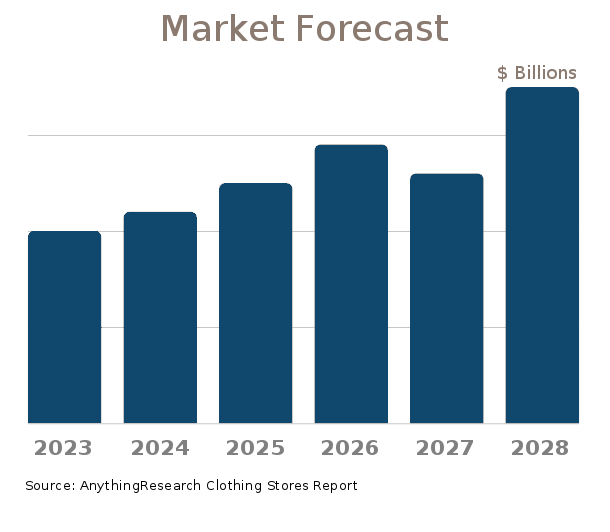2022-2027 Market Forecast
Clothing Stores| Market Forecast | Full Report | |
|---|---|---|
| Current State of the Industry |  |
 |
| Market Forecast (2022-2027) |  |
 |
| Market Size (2017-2021) |  |
 |
| Market Landscape - Leading & Disruptive Companies |  |
 |
| Innovation News |  |
 |
| Products/Services Breakdown |  |
|
| Market Size - per State |  |
|
| Financial Metrics |  |
|
| Salary & Compensation Statistics |  |
|
| Key Companies |  |
|
| Government Vendors |  |
|
| Instant Download - Available immediately upon purchase |  |
 |
| Download now: |


2022-2027 Clothing Stores Market Forecast
U.S. Market Forecast & Outlook
Forecasting the trends in the market size for the Clothing Stores industry is a necessary part of the business planning process. AnythingResearch forecasts are used by- Financial institutions seeking to understand credit-worthiness prior to lending
- Investors evaluating startups, venture opportunities, and equities
- Corporations setting strategy and sales & marketing objectives
- Startups demonstrating the "market opportunity" for their business

| Forecast / Industry Outlook | 2022 | 2023 | 2024 | 2025 | 2026 | 2027 |
|---|---|---|---|---|---|---|
| Market Forecast ($ millions) | ||||||
| Projected Industry Growth Rate (%) | ||||||
The future growth of the Clothing Stores is influenced by internal and external factors. Internal factors include structure and competition within the industry, market demand, and innovative and disruptive factors. External factors include the state of the economy and cyclical patterns.
Clothing Stores Competitor Landscape & Key Companies [PREMIUM]
The most influential companies in the Clothing Stores industry and adjacent industries either have large market share or are developing new business models and methods that could disrupt the status quo. We look at leading and emerging companies in the Clothing Stores industry and adjacent sectors:| Market Leaders: Direct Competitors Companies with the largest market share, focused in this industry |
Market leaders: Diversified Competitors Largest companies that have diversified operations in this and other industries |
| Innovators: Direct Competitors Innovative, Emerging, and Disruptive Companies that may influence the future direction of the industry. |
Innovators: Diversified Competitors Innovators and Disruptors in adjacent industries that may also affect the Clothing Stores industry. |
Source:
Innovation News
- Nobull raises $40 million in funding. - 03/29/2023
- Goumi raises $1 million in funding. - 09/22/2022
- TJX Companies trademarks "GET DEALS, GIVE JOY" - Retail department store services - 07/23/2022
- Walters & Mason Retail trademarks "ALTAR'D STATE UNDER" - Swimwear; Intimate apparel, including lingerie, bras, underwear, and shapewear; Loungewear; Robes - 07/22/2022
- Walters & Mason Retail trademarks "ARBORETUM" - Decorative switch plate covers; decorative socket covers; electric door bells; leather protective covers specially adapted for personal electronic devices; scales - 07/22/2022
- Caastle patents Systems And Methods For Electronic Platform For Transactions Of Wearable Items - 06/23/2022
- Caastle patents Systems And Methods For Inspection And Defect Detection - 06/23/2022
- Caastle patents Systems And Methods For Product Identification Using Image Analysis And Trained Neural Network - 06/09/2022
- Lobby raises $3 million in funding. - 04/27/2021
Executive Briefings
Our business is highly competitive and characterized by low barriers to entry, especially online. The following are several factors important to competing successfully in the retail apparel industry: ability to anticipate fashion trends and customer preferences; product procurement and pricing; breadth of selection in sizes, colors and styles of merchandise; inventory control; quality of merchandise; store design and location; visual presentation and advertising; customer service; and reputation. We face competition in our maternity apparel lines from various sources, including department stores, specialty retail chains, discount stores, independent retail stores and catalog and Internet-based retailers, from both new and existing competitors. Many of our competitors are larger and have substantially greater financial and other resources than us. Our better and premium-priced merchandise faces a highly fragmented competitive landscape that includes locally based, single unit retailers, as well as a handful of multi-unit maternity operations. In the value-priced maternity apparel business, we currently face competition on a nationwide basis from retailers such as Gap®, H Destination Maternity


Related Reports
Can't find what you're looking for? We have over a thousand
market research reports.
Ask us and an analyst will help you find what you need.


